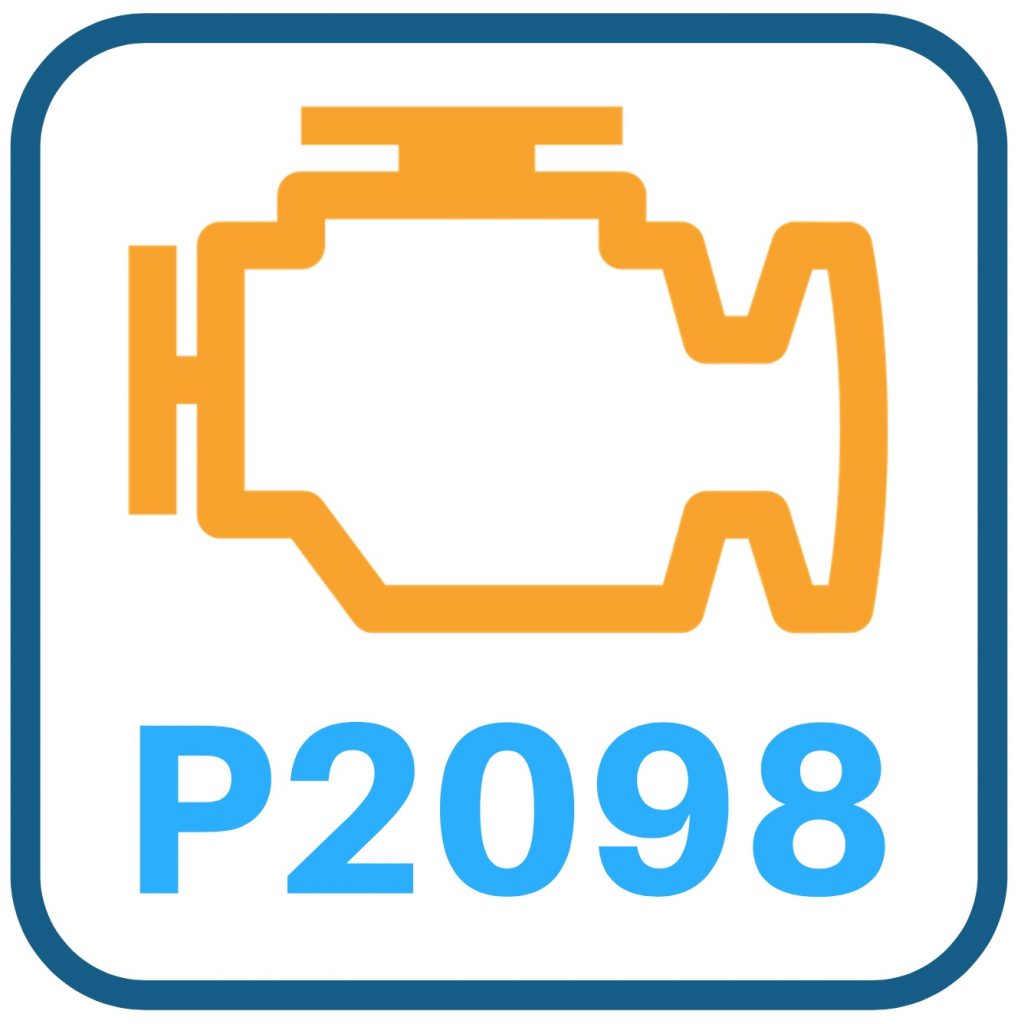P2098 is a generic OBD II code. It specifically indicates that your Nautilus detected a lean condition after the catalytic converter (too much air for the amount of fuel present).
P2098 Definition

This particular code is generic, so it has the same meaning for your Lincoln Nautilus as any other vehicle. There are three parts to the definition. Understanding it can help you make the right diagnosis.
P2098: Post Catalyst – Fuel Trim System Too Lean – Bank 2
Post Catalyst Fuel Trim System
Post catalyst means whatever is happening is after the catalytic converter (in terms of exhaust flow). Your Nautilus’s catalytic converter is responsible for breaking down exhaust gasses and making them inert, which greatly decreases emissions output.
Fuel Trim System Too Lean
The fuel trim system is what your Lincoln Nautilus uses to adjust the air-fuel ratio for optimum combustion. There is an oxygen sensor located after your catalytic converter (on the bank 2 side, we’ll get to that in about 30 more seconds of reading time), reporting that the air/fuel ratio is too lean (too much air in relation to fuel).
The oxygen sensor directly behind the catalytic converter is the one that you’ll be looking for. But first, you’ll need to find bank 2.
Bank 2
The term “bank” refers to a row of cylinders. So, the number of cylinder heads a vehicle has determines the number of banks (it can only be one or two banks).
P2098 can ONLY appear on engines with two banks. So, you’re going to need to determine which side of the engine is bank 2 in your Nautilus.
While it is annoying to have to find bank 2, having two banks is nice since we can use the “swap test” to diagnose and determine if the oxygen sensor is bad or not without using anything other than an end wrench and your OBD2 scanner.
P2098 Symptoms: Lincoln Nautilus
Typically, if your Nautilus registered P2098, there will be noticeable symptoms. Here are some of the most common ones:
- Rough Running Engine– With your Nautilus’s engine running a little too lean, you may notice that it struggles to idle properly. It may also misfire and have a hard time accelerating.
- Knocking– A loud knock is common with P2098.
- Red Catalytic Converter– If your catalytic converter is glowing red, that is a strong indication that it has gone bad. It’s easier to see when it’s dark.
- Check Engine Light– The reason why you are here. A wide range of problems can cause P2098. Make sure to check out the other codes.
- Bad Fuel Mileage– Fuel mileage will almost always suffer from this code being present since the air-fuel mixture is off.
P2098 Causes + Diagnosis: Lincoln Nautilus

Here are the typical causes of P2098. A good code scanner will aid immensely in the diagnosis. Typically, this code will be accompanied by other codes that can help you narrow down exactly what is causing it.
Diagnosing P2098 by itself can be a challenge due to the number of things that can go wrong and throw the code. If any other codes are present, cross-reference the common causes with the ones listed below and see what causes they share in common.
Oxygen Sensor
A bad oxygen sensor is one of the most common reasons that you’ll see P2098. You’ll need to test the sensor and determine if it is bad or good. Here’s more on diagnosing a bad O2 sensor in your Nautilus.
Since P2098 only occurs with engines with two banks, that means that there is a sister code for Bank 1 (P2096). We can use this to our advantage. By swapping the two oxygen sensors, we can determine if the oxygen sensor is the problem. Here’s how it’s done:
- First, clear the DTC codes with your scanner.
- Swap the Bank 2 Sensor 1 O2 sensor with the Bank 1 Sensor 1. They’ll be on or right after each catalytic converter on each side of the exhaust.
- Run the engine until the check engine light comes back on.
- If the code changes to P2096 (which indicates the O2 sensor on Bank 1 is too lean), that is proof enough that your Nautilus needs a new O2 sensor.
- If the code remains P2098, you’ll need to continue pursuing your diagnosis, knowing that both O2 sensors are working fine.
Catalytic Converter
A clogged catalytic converter is a common cause of P2098. A really bad converter will glow red, and your Nautilus will have a hard time accelerating. This happens because it’s so clogged that it can no longer pass exhaust gas freely.
If this is the case, you’ll likely get P0420. Here’s more on diagnosing a bad catalytic converter.
Misfire
A misfire will cause P2098. A misfiring engine does not have to make a noticeable sputter sound. It can be subtle enough that you can’t feel it as you drive your Nautilus. If this is causing the code, it’ll usually be accompanied by a misfire-related trouble code.
Here are the most popular ones:
P0300– Random Multiple Misfire: Something is making all of the plugs misfire. This is harder to fix than just one random cylinder misfiring, but certainly not impossible.
P030X– Misfire in Cylinder X: If this is the case, it indicates that the misfire is in a specific cylinder. For example, P0301 is a misfire in the first cylinder.
Low Fuel Pressure
Low fuel pressure can cause P2098. And, there are a lot of things that can cause low fuel pressure. Such as:
- Bad Fuel Injector(s)
- Bad Fuel Pressure Regulator (you’d see P2096 as well)
- Fuel Filter Clogged
- Fuel Pump
Exhaust Leak
An exhaust leak can cause the oxygen sensors to register that the mixture is too lean. Inspecting for an exhaust leak is pretty easy. Your Nautilus will sound louder than normal somewhere in the exhaust, and it’s usually pretty obvious.
Vacuum Leak
A vacuum leak can let air into the combustion chamber that isn’t supposed to be there. This leans out the mixture and can potentially throw the code in your Nautilus.
Mass Airflow Sensor
If there is an issue with the mass airflow sensor, the PCM will not be able to control the air-fuel mixture properly.
Conclusion: P2098 Lincoln Nautilus
The odds are that a related trouble code will accompany this code. If it is not, start with the easier stuff:
- If it’s not accelerating right but doesn’t seem to have a misfire, it’s probably the catalytic converter. It should feel like it’s running out of wind as the speed increases.
- If your Nautilus is running rough (tachometer needle movement at idle), it could be an unregistered misfire.
- If you hear a whistling sound from under the hood, you probably have a vacuum leak.
- If there seem to be no other symptoms other than the check engine light, bad gas has been known to throw this code by itself. Make sure to use the octane rating that Lincoln recommends.
- Use a code scanner to check how the oxygen sensor is performing during real-world driving. If it is showing erratic readings, it may need to be replaced. Take a look at the wiring around it first and make sure that it is snug and undamaged.
Good luck diagnosing your Lincoln Nautilus. If you discover anything that could help this page’s next visitor, please leave a comment below.

